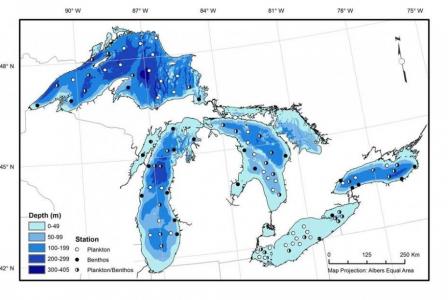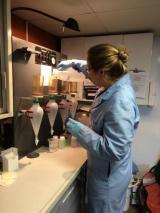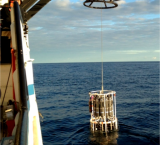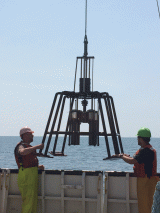The Lake Guardian
 The R/V Lake Guardian sampling in Lake Huron (Image Credit: Michael Milligan)The Research Vessel (R/V) Lake Guardian is the largest research vessel in the U.S. EPA fleet and the largest research vessel operating on the Great Lakes. The R/V Lake Guardian is owned by the EPA Great Lakes National Program Office (GLNPO). The R/V Lake Guardian assists GLNPO in monitoring and reporting on the status and trends of the Great Lakes ecosystem. Annual surveys that sample water and biological life at designated locations in all five Great Lakes (Superior, Michigan, Huron, Erie and Ontario) are conducted by the R/V Lake Guardian.
The R/V Lake Guardian sampling in Lake Huron (Image Credit: Michael Milligan)The Research Vessel (R/V) Lake Guardian is the largest research vessel in the U.S. EPA fleet and the largest research vessel operating on the Great Lakes. The R/V Lake Guardian is owned by the EPA Great Lakes National Program Office (GLNPO). The R/V Lake Guardian assists GLNPO in monitoring and reporting on the status and trends of the Great Lakes ecosystem. Annual surveys that sample water and biological life at designated locations in all five Great Lakes (Superior, Michigan, Huron, Erie and Ontario) are conducted by the R/V Lake Guardian.
On this page:
- The Mission of the R/V Lake Guardian
- The R/V Lake Guardian's Yearly Survey Activities
- The Ship Specifications of the R/V Lake Guardian
- The Types of Sampling Equipment and Laboratories Used Aboard the R/V Lake Guardian
- How Scientists Request to do Research Aboard the R/V Lake Guardian
The Mission of the R/V Lake Guardian
The R/V Lake Guardian assists with GLNPO's mission for monitoring and reporting on the status and trends of the Great Lakes ecosystem. GLNPO has mandates to help restore and protect the health of the Great Lakes as required under the Great Lakes Water Quality Agreement and the Great Lakes Restoration Initiative. Sampling from aboard the R/V Lake Guardian, operating on all five Great Lakes, is used to monitor the water quality and health of the lakes. The R/V Lake Guardian also provides educational opportunities around the Great Lakes basin.
The R/V Lake Guardian's Yearly Survey Activities
 Map showing the R/V Lake Guardian annual survey sampling locations on the Great Lakes.
Map showing the R/V Lake Guardian annual survey sampling locations on the Great Lakes.
The R/V Lake Guardian conducts sampling surveys on all five Great Lakes during both the spring (late March, after ice break-up) and summer (August) seasons. The spring survey monitors lake health during a time of low biological activity, when the lakes are well-mixed. The summer survey monitors lake health during the season of high biological activity, when the lakes are stratified. During these surveys, water, plankton and benthos samples are taken at designated stations throughout each lake. These monitoring surveys have been ongoing in the lakes since 1983, resulting in an exceptional long-term monitoring dataset for evaluating the health of the Great Lakes ecosystem through time.
In addition to the annual spring and summer surveys, the R/V Lake Guardian conducts:
- Dissolved oxygen surveys on Lake Erie,
- Educator cruises through the Illinois-Indiana Sea Great, and
- Cooperative Science and Monitoring Initiative (CSMI) surveys, thoroughly sampling one Great Lake every year, rotating on a five-year cycle.
The Ship Specifications of the R/V Lake Guardian
The R/V Lake Guardian is 180 feet in length, with a gross tonnage of 283 tons, a displaced tonnage of 850 tons, and a cruising speed of 11 knots. It has a berthing capacity of 41 people, including 14 crew members and 27 visiting scientists.
The Types of Sampling Equipment and Laboratories Used Aboard the R/V Lake Guardian
The R/V Lake Guardian is equipped with three dedicated laboratories:
- a general purpose or "wet" laboratory,
- chemistry laboratory, and
- biology laboratory.
How Scientists Request to do Research Aboard the R/V Lake Guardian
During monitoring surveys, EPA offers opportunities for scientists from federal and state governments and universities to conduct research aboard the R/V Lake Guardian. Research compatible with the standard sampling performed at each station is especially encouraged.
The R/V Lake Guardian supports a number of projects every year:
- Research requests for projects funded by U.S. EPA have the highest priority;
- Other projects related to EPA's work receive the second highest priority;
- Projects funded by outside agencies receive the third highest priority.
To request time aboard the R/V Lake Guardian, contact Eric Osantowski (osantowski.eric@epa.gov).



